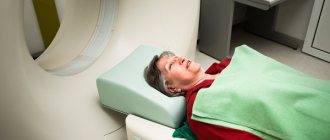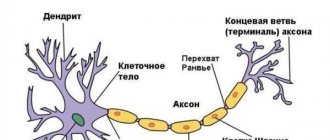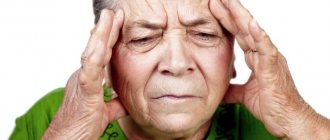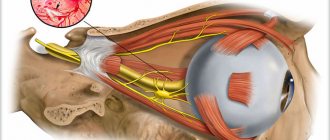A cerebellar tumor is one of the types of brain tumors. A cerebellar tumor can be benign or malignant, with a wide variety of histological structures. Even if the tumor is benign, due to its special location it can pose a direct threat to the patient’s life due to the possibility of infringement of brain structures with impaired breathing and circulation. A cerebellar tumor manifests itself as cerebral, distant and focal (cerebellar) symptoms. To diagnose this pathology, it is mandatory to conduct a computed tomography (CT) or magnetic resonance imaging (MRI) of the brain. Treatment of cerebellar tumors is predominantly surgical. From this article you can learn about the main symptoms, methods of diagnosis and treatment of cerebellar tumors.
Main functions
The cerebellum does a huge amount of work. First of all, it maintains and distributes muscle tone, which is necessary to keep the human body in balance. Thanks to the work of this organ, a person can perform motor function. Therefore, when talking about the function and symptoms of cerebellar damage, the doctor first of all checks the person’s coordination. This is because this organ helps maintain and distribute muscle tone at the same time. For example, when a person bends his leg, he simultaneously tenses the flexor and relaxes the extensor.
In addition, the cerebellum distributes energy and minimizes contraction of the muscles that are involved in performing a particular job. In addition, this organ is necessary for motor learning. This means that during training or developing professional skills, the body remembers which muscle groups contract and tense.
If there are no symptoms of cerebellar damage and its functioning is normal, then in this case the person feels well. If at least one part of this organ suffers from damage, then it becomes more difficult for the patient to perform certain functions, or he simply cannot move.
Forecasting
The result of treatment for a cerebellar tumor depends on the nature of the tumor - benign or malignant.
In the first case, the prognosis is favorable. But with the large size of the benign lesion and its pressure on the cells responsible for the functioning of the respiratory organs and heart, the patient is likely to die.
With malignant tumors, the survival prognosis is much worse. At the initial stage, there is a chance to fully recover, and at a later stage, life expectancy is no more than a year.
Neurological pathology
Due to damage to this important organ, a huge number of serious ailments can develop. If we talk about neurology and symptoms of cerebellar damage, then it is worth noting the most important danger. Damage to this organ leads to poor circulation. The appearance of this pathology can lead to:
- Ischemic stroke and other heart diseases.
- Multiple sclerosis.
- Traumatic brain injury. In this case, the lesion does not always have to affect the cerebellum; it is enough if at least one of its connections is disrupted.
- Meningitis.
- Diseases of a degenerative type, as well as abnormalities caused in the nervous system.
- Intoxication.
- Overdose of certain medications.
- Vitamin B12 deficiency.
- Hydrocephalus of obstructive type.
In neurology, symptoms of cerebellar damage are quite common. Therefore, first of all, it is necessary to visit a specialist in this particular field.
Other reasons for the development of the disorder
In some cases, cerebellar damage is not a consequence, but a symptom. This applies to oncological diseases of the following organs and systems:
- lungs;
- brain;
- ovaries;
- lymph nodes.
The “first bell” of brain cancer can be cerebellopontine angle syndrome. As a result of the growth of a malignant tumor, parts of the brain are compressed and nutrition and neural communication in their cells are disrupted.
With prolonged alcohol dependence, substance abuse and drug addiction, irreversible damage to the cerebellum occurs. Ataxia can also become a hereditary disease. In this case, therapy must be selected in a special way.
What is the cerebellum, its functions and structure:
Cause of cerebellar diseases
In this case, we can talk about injuries, congenital underdevelopment of this area, circulatory disorders, or the consequences of long-term drug use. This can also happen due to toxin poisoning.
If a patient is diagnosed with a congenital defect in the development of this organ, then in this case we are talking about the fact that the person suffers from a disease called Marie's ataxia. This pathology refers to dynamic ailments.
Symptoms of damage to the cerebellum and pathways may indicate a stroke, injury, cancer, infections and other pathologies occurring in the nervous system. Similar illnesses are encountered by people who have had a fracture of the base of the skull or damage to the occipital region of the head.
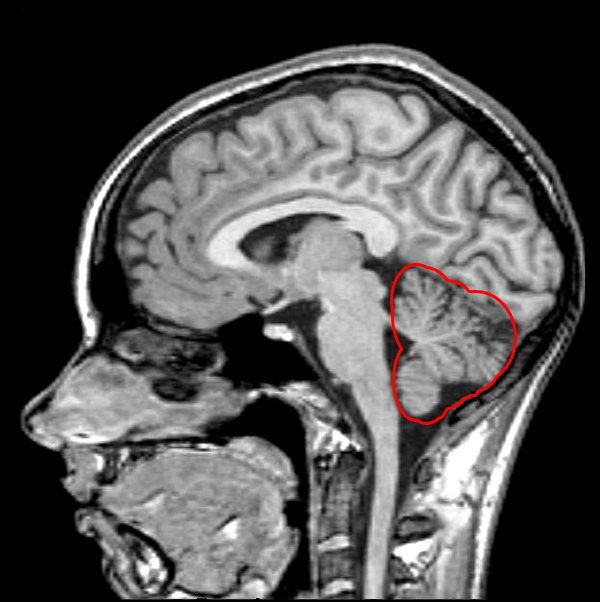
If a person suffers from atherosclerotic vascular lesions, this can also provoke a disruption of the blood supply to the cerebellum. However, the list of all ailments does not end there. Damage to the carotid artery and vascular spasms, which turn into hypoxia, can also provoke a similar condition.
In addition, it should be taken into account that most often symptoms characteristic of cerebellar damage occur in older people. This is explained by the fact that their vessels lose elasticity over time and are affected by atherosclerosis and cholesterol plaques. Because of this, their walls cannot withstand strong pressure and begin to rupture. Such hemorrhage provokes tissue ischemia.
Pain caused by a tumor in the cerebellum
The occurrence of a malignant neoplasm in the cerebellum is manifested by a combination of headaches in the back of the head and neck and a sharp deterioration in vision. Toxic substances released by growing tumors cause congestion of the optic discs. The tissue of the optic nerve fibers senses an increase in intracranial pressure, due to which it atrophies and is replaced by connective tissue. A person experiences problems with vision, and gradually blindness occurs. The process is accompanied by sharp pain in the back of the head, spreading to the neck, and vomiting. Nausea has nothing to do with indigestion and food intake, but is caused by irritation of the nerves of specific areas of the brain stem. Even after inducing a gag reflex, the patient does not feel better. Sometimes, if the tumor puts pressure on the fourth ventricle, the patient experiences hiccups, sweating and increased heart rate.
Signs of pathology
If we talk about the main symptoms of damage to the cerebellum of the brain, then among them is ataxia, which can manifest itself in different ways. However, most often a person’s head and whole body begin to tremble, even with a calm body position. Muscle weakness and poor coordination of movements appear. If one of the hemispheres of the brain is damaged, then the person’s movements will be asymmetrical.
Patients also suffer from tremors. In addition, there are severe problems in the process of flexion and extension of the limbs. Many experience hypothermia. If symptoms characteristic of cerebellar damage occur, the patient may experience motor disturbances. In this case, when moving towards a certain goal, a person begins to perform pendulum actions. In addition, a problem with the cerebellum can cause hyperreflexia, gait disturbances, and severe changes in handwriting. It is also worth considering the types of ataxia of this organ.
Therapeutic measures
The leading treatment method for cerebellar tumors is surgical removal. The appropriateness of its implementation is determined by the doctor after a complete examination of the patient. In case of a benign lesion, it is possible to eliminate the affected area and save a person’s life.
If the pathology is malignant, then it is possible to remove only the formation only in the early stages. If the tumor has grown into neighboring tissues, then it is not possible to eliminate all atypical cells. Then the maximum possible volume of the tumor is excised and chemical and radiation therapy is prescribed to destroy the remaining cancer cells.
Chemotherapy is considered the most effective, but it causes many side reactions in the body. Among them are hair loss, nausea, headache, bowel disorders, etc. Radiation therapy acts directly on the affected area, minimally affecting healthy tissue.
Patients are also prescribed medications to activate the immune system and eliminate pain.
Static-locomotor
In this case, disturbances in a person’s walking are most pronounced. Any movement brings severe stress, which causes the body to become weaker. In this case, it is difficult for a person to be in a position where the heels and toes of the feet are in contact. Difficulty falling forward, backward, or swaying to the sides. In order to take a stable position, a person needs to spread his legs wide apart. There is a very unsteady gait and outwardly the patient who exhibits symptoms of cerebellar damage resembles a drunk. When turning, it can skid to the side, even falling.

To diagnose this pathology, several tests must be performed. First of all, you need to ask the patient to walk in a straight line. If he shows the first signs of static-locomotor ataxia, he will not be able to perform this simple procedure. In this case, he will begin to deviate too much in different directions or spread his legs too wide.
Also, in order to identify the main symptoms of cerebellar damage, additional tests are performed at this stage. For example, you can ask the patient to stand up sharply and turn 90° to the side. A person whose cerebellum is damaged will not be able to perform this procedure and will fall. With such a pathology, the patient also cannot move with an extended step. In this case, he will dance, and the body will begin to lag slightly behind the limbs.
In addition to obvious problems with gait, there is a strong contraction of muscles when performing even the simplest movements. Therefore, in order to determine this pathology, you need to ask the patient to stand up sharply from a lying position. At the same time, his arms should be crossed on his chest. If a person is healthy, then his muscles will contract synchronously, and he will be able to sit down quickly. When ataxia occurs and the first symptoms of cerebellar damage occur, it becomes impossible to simultaneously strain the hips, torso and lower back. A person will not be able to get into a sitting position without the help of his hands. Most likely the patient will simply fall backwards.
You can also ask the person to try bending backwards while standing. At the same time, he must throw back his head. If a person is in a normal state, then in this case he will involuntarily bend his knees and straighten in the hip area. With ataxia, such flexion does not occur. Instead, the person falls.
Dynamic cerebellar ataxia
In this case, we are talking about problems with the smoothness and dimension of human movements. This type of ataxia can be unilateral or bilateral, depending on which hemispheres are affected. If we talk about what symptoms are observed with damage to the cerebellum and the manifestation of dynamic ataxia, they are similar to those described above. However, if we are talking about unilateral ataxia, then in this case the person will have problems moving or performing test tasks only in the right or left side of the body.
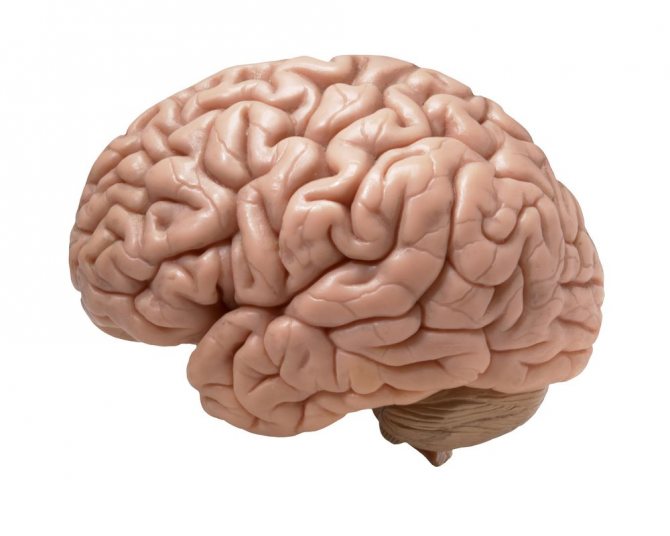
To identify the dynamic form of pathology, it is worth paying attention to some features of human behavior. First of all, he will experience severe trembling in his limbs. As a rule, it intensifies by the time the patient completes the movement. When in a calm state, a person looks absolutely normal. However, if you ask him to take a pencil from the table, at first he will stretch out his hand without any problems, but as soon as he begins to take the object, his fingers will begin to tremble violently.
When determining the symptoms of cerebellar damage, diagnosis includes additional tests. With the development of this pathology, patients experience so-called overshooting and overshooting. This is explained by the fact that a person’s muscles begin to contract disproportionately. The flexors and extensors work much harder. As a result, a person cannot fully perform the simplest actions, for example, putting a spoon in his mouth, buttoning a shirt, or tying a knot in his shoelaces.
In addition, changes in handwriting are a clear sign of this disorder. Most often, patients begin to write large and unevenly, and the letters become zigzag.
Also, when determining symptoms of damage to the cerebellum and pathways, it is worth paying attention to how a person speaks. With the dynamic form of the disease, a sign appears, which in medical practice is called scanned speech. In this case, the person speaks as if in jerks. It divides phrases into several small fragments. In this case, outwardly the patient looks as if he is broadcasting something to a large number of people from the podium.
Other phenomena characteristic of this disease are also observed. They also concern patient coordination. Therefore, the doctor conducts a number of additional tests. For example, in a standing position, the patient should straighten and raise his arm to a horizontal position, move it to the side, close his eyes and try to touch his nose with his finger. In normal conditions, it will not be difficult for a person to perform this procedure. If he has ataxia, he will always miss.
You can also try asking the patient to close his eyes and touch the tips of his two index fingers to each other. If there are problems in the cerebellum, the patient will not be able to match the limbs in the desired way.
Diagnostics
Considering the symptoms of cerebellar damage and research methods, it is worth noting that in case of any disturbances in the functioning of the brain, you must immediately contact a neurologist. He conducts a series of tests in order to clarify how a person’s superficial and deep reflexes work.
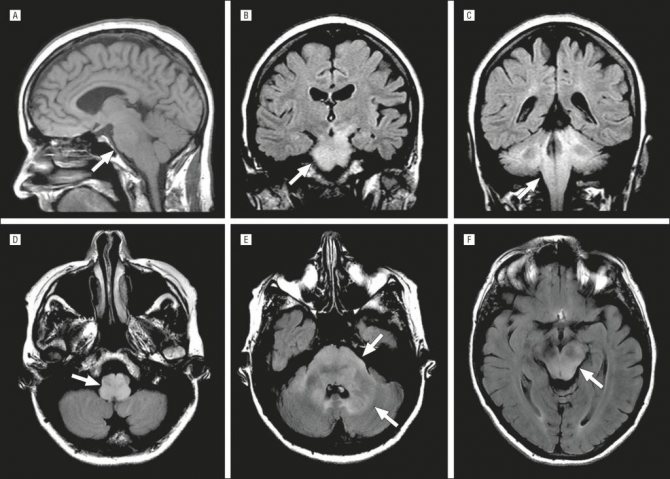
If we talk about hardware studies, it may be necessary to perform electronystagmography and vestibulometry. A general blood test is required. If a specialist suspects an infection in the cerebrospinal fluid, a lumbar puncture is performed. Markers of stroke or inflammation need to be checked. Additionally, an MRI of the brain may be required.
Pain caused by a tumor in the ventricle of the brain
Patients with a brain tumor often note that pain intensifies when tilting the head, laughing, coughing, walking faster, and other body movements. They are accompanied by visual disturbances and double vision. This is typical for a neoplasm located in one of the ventricles (there are only three of them), responsible for the synthesis of cerebrospinal fluid and cerebrospinal fluid. When bending over, the tumor puts pressure on the ventricle. Liquor accumulates in the ventricle, and the tumor aggravates the situation. However, by throwing back the head or turning it in the other direction, the pain symptoms suddenly move to another area of the skull or go away on their own. There is an outflow of cerebrospinal fluid, the ventricle decreases in size, and the state of health temporarily improves. Either the pain moves lower or even moves to the neck area. This is due to the fact that the increased flow of cerebrospinal fluid irritates the cervical roots or nerves of the skull. Wandering headaches indicate a tumor in one of the ventricles of the brain.
Treatment
The success of therapy directly depends on the causes of this pathology. Therefore, speaking about the symptoms and treatment of cerebellar lesions, it is worth considering the most common cases.
If the disease is accompanied by an ischemic stroke, then lysis of blood clots is required. The specialist also prescribes fibrinolytics. To prevent the formation of new blood clots, antiplatelet agents are prescribed. These include Aspirin and Clopidogrel. Additionally, you may need to take metabolic medications. These include Mexidol, Cytoflavin and others. These funds help improve metabolic processes in brain tissue.
In addition, in order to prevent another stroke, it is necessary to take a course of medications that reduce the amount of cholesterol in the blood.
If, when studying the symptoms and causes of damage to the cerebellum, the doctor determines that the patient is suffering from neuroinfections (for example, encephalitis or meningitis), then treatment with antibiotics is required.
Problems caused by intoxication in the body can be solved with the help of detoxification therapy. However, for this it is necessary to clarify the type and characteristics of the poison. In difficult situations, immediate measures must be taken, so the doctor performs forced diuresis. In case of food poisoning, it is enough to perform gastric lavage and take sorbents.
If a patient is diagnosed with cancer, then everything depends on its stage and type of pathology. As a rule, radiation and chemotherapy are prescribed for treatment. In some situations, surgery may be required.

Experts also prescribe drugs that can improve blood flow (for example, “Caviton”), vitamin complexes, anticonvulsants and drugs that strengthen muscle tone.
Physical therapy and massage sessions have a beneficial effect. Thanks to a special set of exercises, it is possible to restore muscle tone. This helps the patient return to normal faster. Physiotherapeutic measures are also carried out (therapeutic baths, electrical stimulation, etc.).
Also, when considering the symptoms, causes and treatment of cerebellar damage, it is worth paying attention to several more brain pathologies encountered in medical practice.
Betten's disease
This pathology belongs to the category of hereditary diseases. It doesn't happen that often. In this case, a person exhibits all the signs of cerebellar ataxia, which are recorded in babies in the first 12 months of life. Serious problems in coordination appear, the child cannot focus his gaze, and muscle hypotonia appears.
Some children begin to hold their heads independently only by the age of 2-3 years, and later begin to speak and walk. However, in most cases, after a few years, the baby’s body adapts to the pathology, and the signs of cerebellar damage cease to be obvious.
Medulloblastoma
First of all, let us note the features of the development of this cerebellar tumor in children. Symptoms in younger children are in most cases mild. Are limited to the following:
- Changing habitual behavior.
- Some increase in head circumference.
- Lethargy and apathy.
- Vomit. This syndrome occurs more often in older children than in infants.
When examining a small patient, a specialist may identify an anterior protruding fontanelle, as well as a divergence of the skull bones. Older children often experience statistical ataxia, pathological head tilt, and altered gait. What does this mean? An abnormal tilt of the head indicates both trochlear nerve palsy and growth of the tumor towards the foramen magnum. A potential threat to the patient’s life is the protrusion of the cerebellar tonsils into this hole. This happens due to the same pressure of the tumor on the brain.
Alcoholic cerebellar degeneration
A similar pathology appears against the background of chronic intoxication with alcoholic beverages. In this case, the cerebellar vermis is affected. First of all, when diagnosing the disease, patients experience problems with limb coordination. Sight and speech are impaired. Patients suffer from severe memory loss and other problems with brain activity.
Based on this, it becomes obvious that problems with the cerebellum appear against the background of other pathologies. Although neurological problems most often lead to ataxia, this is not the only factor that affects a person’s health. Therefore, it is important to promptly pay attention to the symptoms, contact a qualified specialist and conduct a diagnosis. Simple tests can be performed at home. However, after this you need to consult a doctor, identify the main cause of the unpleasant disease and begin immediate treatment with drugs and physiotherapy.

